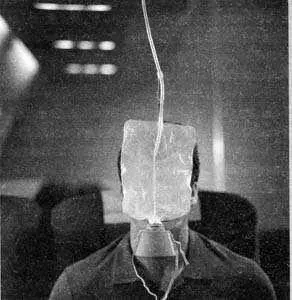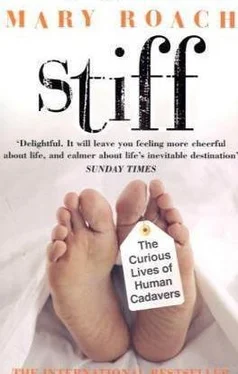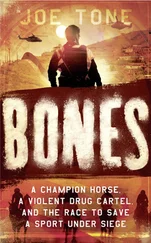I asked Kress, in an e-mail exchange, whether he has had occasion to wrangle a cadaveric crotch into an athletic cup and take aim at it with baseballs, hockey pucks, what-have-you. He has not, nor is he aware of any sports injury researcher who has. “You would think that… ‘racking’—i.e., scrotal impacts— would be a high research priority,” he wrote. “I’m thinking no one wants to go there in the lab.”
Which is not to say that science does not, occasionally, go there. At the local medical school library, I ran a Pub Med search for journal articles featuring the words “cadaveric” and “penis.” With the monitor shoved back as far as possible into the cubicle, lest the people on either side of me see the screen and alert the librarian, I browsed twenty-five entries, most of them anatomical investigations. There were the urologists from Seattle investigating the distribution pattern of dorsal nerves along the penile shaft (twenty-eight cadaver penises). [18] This was a joint effort involving the living and the dead, with the dead getting the shorter end of the stick: Following dissections of the dead penises, “10 healthy males” agreed to help confirm the findings by undergoing electrical stimulation of the dorsal nerve, as healthy males are wont to agree to.
There were the French anatomists injecting red liquid latex into penile arteries to study vascular flow (twenty cadaver penises). There were the Belgians calculating interference of the ischiocavernosus muscles in rigidity during penile erection (thirty cadaver penises). For the past twenty years, all the world over, people in white coats and squeaking shoes have been calmly, methodically making the cut that dare not speak its name. It makes Tyler Kress seem like a cream puff.
On the other side of the gender gap, a Pub Med search on “clitoris” and “cadaver” turned up but a single entry. Australian urologist Helen O’Connell, author of “Anatomical Relationship Between Urethra and Clitoris” (ten cadaver perinea), bristles at the disparity: “Modern anatomy texts,” she writes, “have reduced descriptions of female perineal anatomy to a brief adjunct after a complete description of the male anatomy.” I picture O’Connell as a sort of Gloria Steinem of the research set, the fast-moving, can-do feminist in a lab coat. She is also the first researcher I’ve come across in my haphazard wanderings to have worked with infant cadavers. (She did this because the comparable male erectile tissue research had, for reasons not explained, been done on infants.) Her paper states that she obtained ethical approval from the Victorian Institute of Forensic Pathology and the Board of Medical Research of the Royal Melbourne Hospital, which clearly don’t go about their business with the grim specter of media evisceration foremost in their minds.
5. BEYOND THE BLACK BOX
When the Bodies of the Passengers Must Tell the Story of a Crash

Dennis Shanahan works in a roomy suite on the second floor of the house he shares with his wife, Maureen, in a subdivision ten minutes east of downtown Carlsbad, California. The office is quiet and sunny and offers no hint of the grisly nature of the work done within. Shanahan is an injury analyst. Much of the time, he analyzes the wounds and breakages of the living. He consults for car companies being sued by people making dubious claims (“the seat belt broke.” “I wasn’t driving,” and so on) that are easily debunked by looking at their injuries. Every now and then the bodies he studies are dead ones. Such was the case with TWA Flight 800.
Bound for Paris from JFK International Airport on July 17, 1996, Flight 800 blew apart in the air over the Atlantic off East Moriches, New York.
Witness reports were contradictory. Some claimed to have seen a missile strike the aircraft. Traces of explosives had turned up in the recovered wreckage, but no trace of bomb hardware had been found. (Later it would come out that the explosive materials had been planted in the plane long before the crash, as part of a sniffer-dog training exercise.) Conspiracy theories sprouted and spread. The investigation dragged on without a definitive answer to the question on everyone’s mind: What—or who—had brought Flight 800 down from the sky?
Within days of the crash, Shanahan flew to New York to visit the bodies of the dead and see what they had to say. Last spring, I flew to Carlsbad, California, to visit Shanahan. I wanted to know how—scientifically and emotionally—a person does this job.
I had other questions for him too. Shanahan is a man who knows the reality behind the nightmare. He knows, in grim medical detail, exactly what happens to people in different types of crashes. He knows how they typically die, whether they’re likely to have been cognizant of what was happening, and how—in a low-altitude crash, anyway—they might have increased their chances of survival. I told him I would only take up an hour of his time, but stayed for five.
A crashed plane will usually tell its own story. Sometimes literally, in the voices on the cockpit flight recorder; sometimes by implication, in the rendings and charrings of the fallen craft. But when a plane goes down over the ocean, its story may be patchy and incoherent. If the water is especially deep or the currents swift and chaotic, the black box may not be recovered, nor may enough of the sunken wreckage be recovered to determine for sure what occurred in the plane’s last minutes. When this happens, investigators turn to what is known in aviation pathology textbooks as “the human wreckage”: the bodies of passengers. For unlike a wing or a piece of fuselage, a corpse will float to the water’s surface. By studying victims’ wounds—the type, the severity, which side of the body they’re on—an injury analyst can begin to piece together the horrible unfolding of events.
Shanahan is waiting for me when I arrive at the airport. He is wearing Dockers, a short-sleeved shirt, and aviator-frame glasses. His hair lies neatly on either side of a perfectly straight part. It could almost be a toupee, but isn’t. He is polite, composed, and immediately likable. He reminds me of my pharmacist Mike.
He isn’t at all what I’d had in mind. I had imagined someone gruff, morgue-hardened, prone to expletives. I had planned to do my interview in the field, in the aftermath of a crash. I pictured the two of us in a makeshift morgue in some small-town dance hall or high-school gym, he in his stained lab coat, me with my notepad. This was before I realized that Shanahan himself does not do the autopsies for the crashes he investigates. These are done by teams of medical examiners from nearby county morgues. Though he goes to the site and will often examine bodies for one reason or another, Shanahan works mostly with the autopsy reports, correlating these with the flight’s seating chart to identify clusters of telltale injuries. He explained that visiting him at work on a crash site might have required a wait of several years, for the cause of most crashes isn’t a mystery, and thus input from the cadavers isn’t often called for.
When I tell him I was disappointed over not being able to report from the scene of a crash, Shanahan hands me a book called Aerospace Pathology , which, he assures me, contains photographs of the sorts of things I might have seen. I open the volume to a section on “body plotting.” Among line sketches of downed plane pieces, small black dots are scattered. Leader lines spoke away from the dots to their labels: “brown leather shoes,” “copilot,” “piece of spine,” “stewardess.” By the time I get to the chapter that describes Shanahan’s work—“Patterns of Injury in Fatal Aircraft Accidents,” wherein photo captions remind investigators to keep in mind things like “intense heat may produce intracranial steam resulting in blowout of the cranial vault, simulating injuries from impact”—it has become clear to me that labeled black dots are as up-close-and-personal as I wish to get to the human wreckage of a plane crash.
Читать дальше













